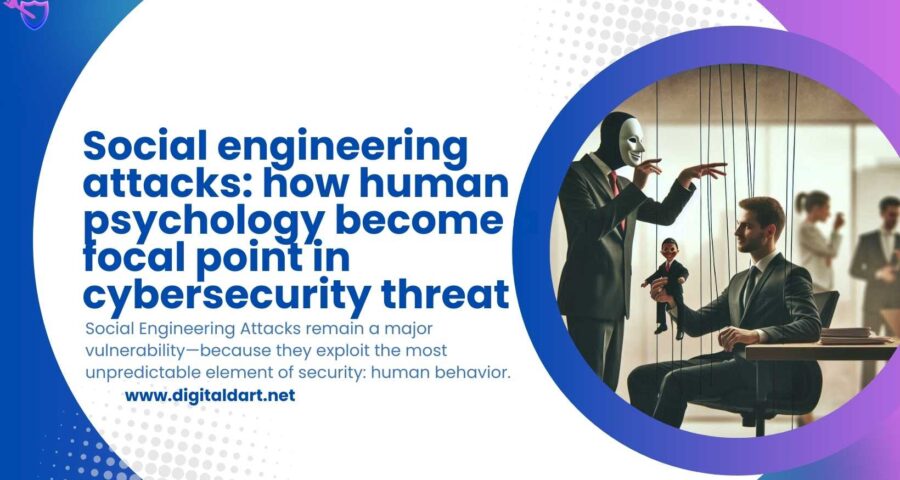Introduction: Social Engineering Attacks
In an era where technical defenses grow ever stronger, Social Engineering Attacks remain a major vulnerability because they exploit the most unpredictable element of security: human behavior. From deceptive emails to persuasive phone calls, attackers manipulate individuals into revealing confidential information or performing actions that compromise an organization’s safety. Understanding Social Engineering Attacks and how they work is critical for building a robust cybersecurity posture that goes beyond firewalls and antivirus software.
Understanding Social Engineering Attacks
Definition and Overview of Social Engineering Attacks
Social Engineering Attacks are tactics that rely on psychological manipulation rather than technical exploits. Rather than hacking into systems directly, attackers trick people into giving away credentials, clicking malicious links, or divulging sensitive data.
Why Humans Are the Weakest Link
Trust and Authority Bias: People naturally comply with perceived authorities.
Curiosity and Urgency: Attackers create a sense of urgency to prompt impulsive actions.
Overconfidence: Individuals often believe “it won’t happen to me,” lowering their guards.
Common Types of Social Engineering Attacks
Phishing Attacks
Phishing remains the single most common tactic used in these Human-Centric Cyber Attacks. Attackers send emails that appear legitimate often mimicking banks, vendors, or colleagues to lure recipients into clicking a malicious link or downloading an infected attachment.
Spear Phishing
Unlike broad phishing campaigns, spear phishing zeroes in on specific targets using personalized information. By referencing real projects or known contacts, attackers gain trust and increase the likelihood of success.
Pretexting
Pretexting involves fabricating a scenario to persuade a target to share information. Common examples include callers posing as IT support or senior executives requesting password resets.
Baiting and Quid Pro Quo
Baiting: Attackers leave infected USB drives in public places, relying on curiosity to infect systems when found.
Quid Pro Quo: An attacker offers a service (e.g., “free” software or support) in exchange for login credentials or network access.
Tailgating and Physical Intrusion
Not all Social Engineering Attacks are digital. Tailgating occurs when an unauthorized individual follows an employee through a secure door, bypassing physical controls.
Techniques Used by Attackers
Psychological Manipulation
Attackers exploit cognitive biases like reciprocity (“I did you a favor, now you do one for me”) to build rapport and lower defenses.
Urgency and Fear Tactics
Creating a fake “emergency” (e.g., “Your account will be closed unless…”) pressures targets to act quickly without verifying authenticity.
Authority Impersonation
Posing as a high-level executive or trusted vendor causes employees to override normal security checks.
Consequences of Social Engineering Attacks
Data Breaches and Financial Loss
Successful Human-Centric Cyber Attacks can lead to stolen credentials, unauthorized transactions, and large-scale data breaches that cost companies millions.
Reputation Damage and Trust Erosion
Beyond immediate financial fallout, breaches erode customer trust and can result in lasting reputational harm that’s hard to recover from.
How to Prevent Social Engineering Attacks
Employee Training and Awareness Programs
Regular Workshops: Simulated phishing tests and role-playing exercises raise awareness.
Clear Reporting Channels: Encourage staff to report suspicious emails or calls without fear of reprimand.
Implement Strict Verification Protocols
Call-Back Procedures: Always verify requests by contacting the requester through an independent channel.
Multi-Person Approval: Require two or more people to authorize sensitive transactions.
Use Technology to Bolster Defenses
Email Filters: Advanced spam filters and domain-based message authentication (DMARC, DKIM).
Behavioral Analytics: Systems that detect anomalies in user actions or login patterns.
Role of Technology in Mitigating Social Engineering Attacks
Multi-Factor Authentication
Requiring additional verification such as SMS codes or hardware tokens, adds a layer of defense even if credentials are compromised.
VPN Services and Secure Communication
Encrypting all traffic through a trusted VPN prevents attackers from intercepting credentials or session cookies when employees work remotely.
Best Practices for Organizations to avoid Social Engineering Attacks
Regular Security Audits and Simulations
Red Team Exercises: Internal teams mimic attackers to expose weaknesses in both human and technical defenses.
Phishing Campaign Reviews: Analyze click rates and tailor future training to address gaps.
Incident Response Planning
Maintain an up-to-date incident response plan that outlines steps for containment, eradication, and communication following a successful Social Engineering Attack.
Conclusion: Social engineering attacks
While advanced firewalls and intrusion detection systems are essential, they’re only one part of a comprehensive cybersecurity strategy. Because Social Engineering Attacks target human psychology, organizations must invest in continuous training, strict protocols, and supportive technologies like VPNs to close the gap.
For complete protection, covering both human and technical vulnerabilities, partner with Digital Dart, the premier VPN service provider. Their secure, high-performance VPN solutions ensure that your teams can communicate and collaborate safely, no matter where they are.
Ready to strengthen your human firewall and shield your data?
Contact Digital Dart today for a free consultation and discover how our VPN services complete your cybersecurity defense.


Leave a Reply